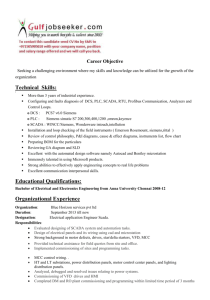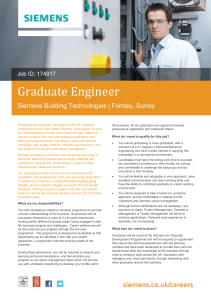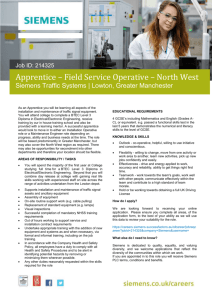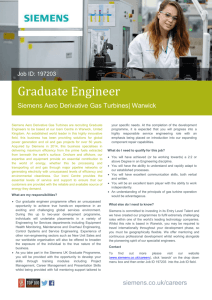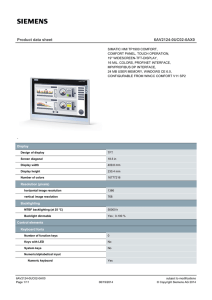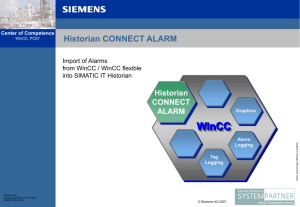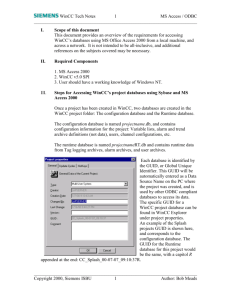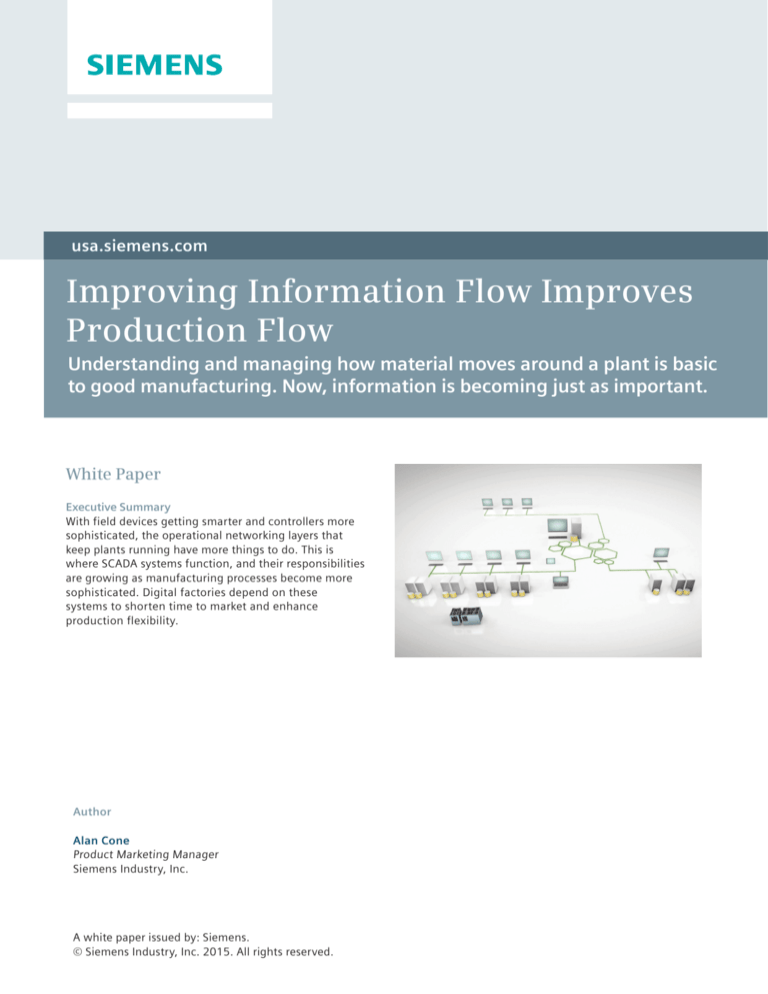
usa.siemens.com
Improving Information Flow Improves
Production Flow
Understanding and managing how material moves around a plant is basic
to good manufacturing. Now, information is becoming just as important.
White Paper
Executive Summary
With field devices getting smarter and controllers more
sophisticated, the operational networking layers that
keep plants running have more things to do. This is
where SCADA systems function, and their responsibilities
are growing as manufacturing processes become more
sophisticated. Digital factories depend on these
systems to shorten time to market and enhance
production flexibility.
Author
Alan Cone
Product Marketing Manager
Siemens Industry, Inc.
A white paper issued by: Siemens.
© Siemens Industry, Inc. 2015. All rights reserved.
White paper | Siemens Factory Information Flow
The world is becoming more competitive for manufacturers
every day. The only way for a company to remain profitable
is to drive efficiency relentlessly, taking advantage of every
possible opportunity to remove cost from products, shorten
time to market for new developments, and enhance
production flexibility. Automation can be a major contributor
to such efficiency, but it has to be approached in a way that
is, in itself, efficient. Automation, applied haphazardly,
may be some help but not nearly as much as it can when
fully integrated.
How should a well-designed automation project proceed?
Consider the lifecycle of a product:
¢ Product design
¢ Production planning
¢ Production engineering
¢ Production execution, and
¢ Service
Services
Production execution
Production engineering
Production planning
Product design
Traditionally, these steps follow a predictable path, one
after the other, moving from department to department.
The marketing department puts together a new product’s
requirements: what it needs to do and the attributes
necessary to be competitive. The product is then designed
in a way to fill as many of those as possible. The production
planning group makes sure it can be built as required and it
works with production engineering to consider the actual
manufacturing steps, what can be done in-house vs. what
should be farmed out, what new manufacturing processes
might be needed, tooling, fixtures, and so on. Prototypes
might be made and sent back to the earlier stages for
evaluation, and another iteration or two or three might
be needed with various compromises before everyone is,
hopefully, happy. Then actual manufacturing begins which
might involve another design tweak or two. Once units are
in the field, service comes into the picture.
It is a predictably slow process, more often than not. Steps in
the process happen in a serial manner and sometimes move
backwards as much as forward. There is an alternative.
A white paper issued by: Siemens.
© Siemens Industry, Inc. 2015. All rights reserved.
Digital Factories
Consider this approach: when
marketing brings its product idea
to the design department, it is
developed virtually. This isn’t
merely 3-D modeling, virtual
design involves a much wider range of product
characteristics and attributes. It’s collaboration, where all
manufacturing departments can participate in the process
at the same time, examining the product on the screen
without having to make any prototypes. Each department
can make its comments:
¢ “The handle will be difficult to mold like that, can we change the shape at this point?”
¢ “We can make the assembly easier if we do this
component in two parts.”
¢ “Are we sure there will be adequate battery life?”
¢ “This surface is going to be subject to wear, so maybe
we should consider a tougher material.”
All of these discussions can happen at the same time
so that when the first prototype is produced, it will be
much closer to the ideal envisioned at the outset. Once
the product has moved into full-scale manufacturing,
production happens in a predictable way because all the
aspects of the product were anticipated. The design process
considers the available manufacturing capabilities and
constraints, even down to cycle times and production rates.
Information Flows with Material
In most manufacturing environments, the biggest concern
is material flow: how do products move through the
process? Increasingly, information flow is just as important.
Controllers and field devices have grown in sophistication,
increasing their capabilities and ability to generate data.
Getting that data to the parts of the process or people that
can use it can be a challenge, and success can make or
break the value of automation.
Think of the levels of communication
in most manufacturing environments,
discrete or process. They separate
nicely into five divisions from the
top down:
• Enterprise
• Management
• Operations
• Control
• Field devices
White paper | Siemens Factory Information Flow
Traditionally, while control efforts flow down, information
flows up. Each level gathers data from the level below,
coalesces and maybe interprets it, and moves it up to the
next level. But that picture is changing. More intelligence
has been pushed down so lower levels have to be more
sophisticated. This puts more pressure on the middle –
the operations level – and makes its function all the more
important. This is where SCADA (supervisory control and
data acquisition) systems do their work, and the nature of
that work is changing.
With all the data coming from the plant floor, how do we
make it into smart data and use it to create smart reports?
Much of that processing takes place
at the operations level by the SCADA
system. SIMATIC WinCC is Siemens’
SCADA system, which includes a
family of products, each with its
own capabilities and applications.
With all its parts working together,
WinCC is the glue that joins all the
different parts of the manufacturing process into one
effective whole supporting efficiency from engineering
to operations.
Consider some of the functions it performs:
¢ Brings data from multiple sources to one place in real time, avoiding lags and clumps of information isolated around a plant
¢ Interfaces with control platforms from various
manufacturers in process or factory automation
environments
¢
Scales easily with requirements
¢
Provides visualization, control, alarming, messaging,
trending and archiving of all the plant level data
even run a single packaging line or machine when a full SCADA system is not necessary.
¢SIMATIC Process Historian can collect any data imaginable
about a process and make it accessible for analysis
and report writing.
¢SIMATIC Information Server interfaces with WinCC and Process Historian to create reports. It uses an Internet interface with a reporting framework and mechanisms to create a variety of formats.
¢WinCC Performance Monitor is a data analysis and
reporting tool that helps users monitor production
capabilities, establish baselines and break through
bottlenecks. It uses diagnostics from field devices to help identify constraints that might be slowing
production or locates where problems are developing with machinery before an outage disrupts production.
Looking at the Parts
WinCC is indeed a family of products that can be fitted
and assembled to provide the capabilities needed for any
specific situation.
¢
WinCC V7.3 is the main platform and has been evolving over the last 20 years. Most recent refinements have been additions to make it function seamlessly with TIA Portal. It is suitable for most applications, but has a maximum limit of 256,000 tags. Multiple engineers can work on the same project at the same time, using many of the same techniques of familiar software platforms such as Microsoft Excel.
¢WinCC OA (Open Architecture) is particularly suited for those large-scale, widely-distributed applications,
scattered over large geographic areas or those with thousands of servers and millions of tags.
¢WinCC Runtime Professional supports HMI applications when all the equipment is close together, and it can A white paper issued by: Siemens.
© Siemens Industry, Inc. 2015. All rights reserved.
¢WinCC Web Navigator and WinCC WebUX are
mechanisms to provide remote information access.
Web Navigator is the earlier platform and interfaces
using Microsoft Internet Explorer. It permits mobile control along with data analysis. WebUX (User
Experience) is a newer tool more aimed at reporting.
It can operate with any browser and any type of
device using HTML 5.
White paper | Siemens Factory Information Flow
Common Elements
All of these parts are designed to work together seamlessly
using a high level of consistency for functions and lookand-feel. Operator familiarity with one part of the system
will support new parts, minimizing the need for training.
These elements also interface with TIA Portal and can be
integrated into larger complex automation systems, even
across multiple plants.
Infrastructure for a Digital Factory
Digital factory technology is bringing new capabilities to
manufacturers in all industries, allowing them to increase
efficiencies, reduce costs and shorten design times for
new products. The combination of smart devices with
sophisticated controllers all working together under
a SCADA system that can support and integrate the
highest functionalities can unleash a higher level of
manufacturing potential for any facility. Siemens can
provide the full range of products, from digital design
platforms to all the equipment necessary to automate
your manufacturing processes. Built on one common
and thoroughly integrated platform, it shortens your
path to a new manufacturing environment.
Subject to change without prior notice
Order No: HMWP-SCADA-0715
Printed in USA
All rights reserved.
© 2015 Siemens Industry, Inc.
Siemens Industry, Inc.
3333 Old Milton Parkway
Alpharetta, GA 30005
usa.siemens.com
All trademarks used are owned by
Siemens or their respective owners.
A white paper issued by: Siemens.
© Siemens Industry, Inc. 2015. All rights reserved.




